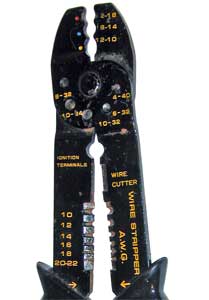Cable crimping
Crimping electrical cable joints
(work in progress article - to have photographic demo of crimped cable joints)
Note that this article refers to the jointing of electrical cable in fixed wiring installations, not for extending flexible cables connected to appliances
Acceptable jointing methods
There are various situations where it may become necessary to join an electrical cable, such as when effecting repairs and upgrades to installations. The wiring regulations basically allow for four methods for making cable joints:
- Screw terminal connections
- Joints produced by a compression tool (i.e. Crimped)
- Soldered Joints
- Welded Joints
1) is most commonly used in electrical accessories such as switches and sockets. However this method is only acceptable where the joint will remain accessible for future inspection and maintenance, since screwed terminal connections can become loose over time.
4) Is not an option readily available in many domestic situations. Hence if one needs to make a joint that is robust, and can be safely entombed into a building we are left with 2) & 3).
Why Crimping
Crimping is a quick and reliable method of jointing that is easy to deploy in the field since unlike soldering it does not require time to be spent waiting for a soldering iron to heat up, and poses no burn risk to the operator when working on confined spaces.
Required Tools and Materials
For making reliable crimped joints the correct crimping tool must be used. Adequate crimping tools are of a substantial contruction and include a ratchet tightening mechanism that ensure adequate pressure is applied to the crimp before it is released. A suitable tool is available from most good tool shops and electrical retailers such as [this].
Crimp terminals are available in a number of sizes and two basic types: [Insulated] and [Uninsulated]. Both types can be used, but the procedure is different, and uninsulated crimps require the use of a different crimp tool to insulated ones. For the purposes of this article we will use insulated crimps since these are the more commonly available, and require a little less work to use.
The wrong tool for the job
Note that the cheap non ratchet crimp tools like this are not suitable:
If you have one of these, save it for stripping wire and cropping small bolts.
The crimping procedure
Prepare the wire
Select suitable crimps
Fit insulation
Crimp
Test
Heatshrink
--John Rumm 04:00, 16 May 2007 (BST)
